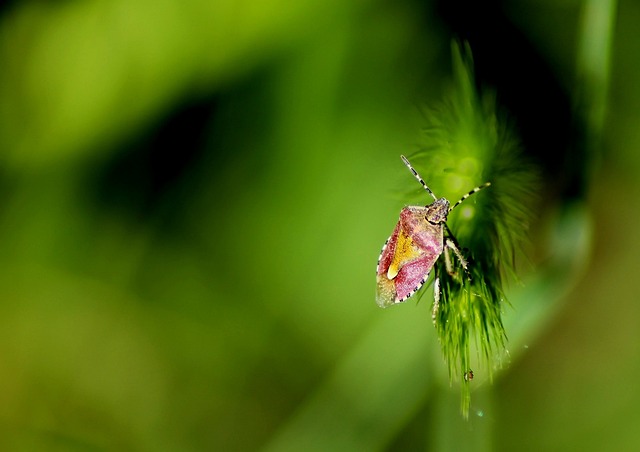Boxelder bugs (Boisea trivittatis), prevalent in areas with boxelder trees, are 1/4-inch long reddish-brown pests with distinctive white wing markings. Active during warmer months and indoor migrants in colder seasons, they prefer woody plants and habitats offering shelter and easy access to food. Professional boxelder bug control services offer eco-friendly solutions like targeted treatments and sticky traps for both residential and commercial properties, ensuring effective extermination while minimizing environmental impact. Understanding their complete metamorphosis cycle involving eggs, nymphs, adults, and their preference for tree bark, siding cracks, windowsills, and corners aids in implementing these controls.
“Unraveling the intricate life cycle of the Boxelder Bug is a crucial step in effective population management. This common pest, known for its distinctive appearance and habit of congregating on windows during autumn, can quickly become a nuisance in both residential and commercial settings.
Our comprehensive guide offers an in-depth look at identifying these bugs, understanding their life stages, exploring control methods, and implementing long-term prevention strategies. From professional removal techniques to eco-friendly solutions, we provide practical insights for both homeowners and businesses seeking efficient Boxelder Bug control services.”
Identifying Boxelder Bugs and Their Habitats
Boxelder bugs (Boisea trivittatis) are a common pest in residential and commercial settings, particularly in areas with abundant boxelder trees. Identifying these insects is the first step towards effective management. Adult boxelder bugs are approximately 1/4 inch long, reddish-brown in color, and have distinctive white markings on their wings. They are active during the day and can be found in large numbers gathering on sunny sides of buildings, tree trunks, or other warm surfaces.
These pests prefer habitats that offer both shelter and easy access to food sources. Common locations include tree bark, cracks in siding, windowsills, and corners of buildings. In residential areas, they often nest near windows or doors, while commercial properties may experience higher populations due to larger, more attractive outdoor spaces. Professional boxelder bug removal services often employ eco-friendly solutions, such as targeted treatments and habitat modification, to manage and control these pests effectively without resorting to harsh chemicals.
– Key characteristics and behaviors of boxelder bugs
Boxelder bugs (Boisea trivittata) are a common pest in North America, known for their distinctive black and red markings and ability to quickly multiply. These insects go through a complete metamorphosis, with four distinct life stages: egg, nymph, adult male, and adult female. They are most active during the warmer months, migrating indoors during the colder seasons, making them a year-round concern for both residential and commercial properties.
Key characteristics include their preference for woody plants, especially boxelder trees, from which they get their name. Adult bugs can fly short distances but are more known for crawling and jumping. They are attracted to light, leading to high populations in areas with significant artificial lighting. While they don’t bite or spread diseases, their presence can be a nuisance, causing damage to walls, furniture, and fabrics due to their feeding habits. Professional boxelder bug removal services often employ eco-friendly solutions, like targeted treatments and sticky traps, to effectively manage populations without resorting to harmful chemicals.
– Common areas where they are found (residential vs. commercial)
Boxelder bugs (Boisea trivittata) are a common pest found in both residential and commercial settings, particularly in areas with warm climates and abundant tree species like maple, boxelder, and ash. In residences, they often congregate in large numbers during the fall and winter months, seeking shelter from the cold. Cracks and crevices around windows, doors, and exterior walls provide easy access to homes, where they may establish breeding grounds. Commercial properties, on the other hand, can attract boxelder bugs due to the availability of food sources like trees and shrubs, as well as suitable habitats such as attics, crawl spaces, and storage areas.
While some homeowners might attempt DIY methods for boxelder bug control services, professional intervention is often necessary, especially for severe infestations. Eco-friendly boxelder bug solutions, which employ integrated pest management (IPM) techniques, are gaining popularity. These approaches focus on preventing and reducing pest problems through a combination of biological, cultural, physical, and chemical methods. For both residential and commercial settings, professional boxelder bug removal specialists can implement targeted treatments, including insecticides and non-toxic solutions, to effectively manage and exterminate these pests while minimizing environmental impact.
The Boxelder Bug Life Cycle: Understanding the Different Stages
The boxelder bug life cycle is a fascinating yet complex process that plays a significant role in understanding and managing these pests. It begins with eggs laid by adult female bugs, typically in the late summer or early fall. These oval-shaped, microscopic eggs are deposited on suitable surfaces, often tree bark, wooden structures, or outdoor furniture. After a few weeks, the eggs hatch, revealing tiny nymphs that closely resemble adult bugs but lack wings.
Nymphs undergo several molts as they grow, shedding their skin to accommodate their increasing size. This process can take several weeks, during which they feed on a variety of plant juices and sometimes other insects. Once fully grown, nymphs develop wings and transform into the more familiar adult boxelder bugs. Adults are typically active in the spring and fall, seeking food sources and mates, before hibernating during the winter months. Understanding these distinct stages is crucial for those seeking effective boxelder bug control services, whether it’s for residential or commercial spaces, with options ranging from professional boxelder bug removal to eco-friendly solutions.
Understanding the boxelder bug life cycle is key to effective management and control. By recognizing their distinct stages, from egg to adult, homeowners and commercial properties can implement tailored strategies for prevention and pest control. While traditional extermination methods exist, many turn to professional services that offer eco-friendly solutions, ensuring a safe and sustainable approach to boxelder bug removal. With the right expertise, it’s possible to minimize infestations without compromising environmental balance, providing lasting relief from these pesky insects.
